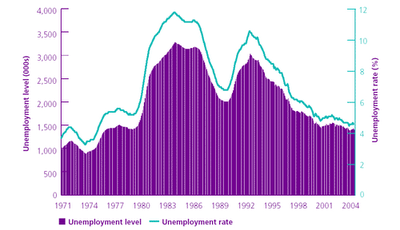Snip
|
Brief History of Unemployment in UK
|
|---|
Categories |
|
|---|
For Snip |
loading snip actions ... |
|---|---|
For Page |
loading url actions ... |
Brief History of Unemployment in UK
 Source: Dept for Work and Transport
Source: Dept for Work and TransportAfter the ravages of the Great Depression era where unemployment was over 25%, unemployment in the UK remained relatively low from 1945 until the late 1970s. When Beveridge introduced the Welfare State in 1945, one thing he mentioned was the necessity of maintaining full employment. Using demand management policies and benefiting from a boom in global trade, the UK more or less achieved full employment, until the 1970s. In the 1970s, rising oil prices caused stagflation and unemployment began to rise but was still relatively low.
It was in the manufacturing recession of 1981 when unemployment rose to unprecedented levels. Not only did unemployment reach 3 million, but, it remained stubbornly high until 1986 well into the economic recovery. The huge rise in unemployment was due to the strong value of the Pound, high interest rates and the deflationary impact of strict Monetarist policies. In particular, it was the manufacturing sector that suffered. Male full time, unskilled labour was particularly affected.
Unemployment remained high throughout the 1980s. Even at the peak of the boom in 1989, 1.6 million people were unemployed. This figure involved high rates of structural unemployment (also known as the natural rate of unemployment). This structural unemployment was because the recession of 1981 had made many unskilled workers unemployed. In the fast changing workplace, these former coal miners and ship builders struggled to get work in the new economy. Geographical unemployment was also a strong feature of the 1980s. Former areas of manufacturing and mining, struggled to cope with the large scale redundancies.
In 1991, unemployment rose again, as the economy slipped into another recession. Unemployment peaked in 1993 at just under 3 million. Unlike the 1980s, unemployment fell quicker. From the mid 1990s to 2008, UK unemployment was relatively low. Looking at official statistics, unemployment was fairly close to full employment at just over 3%.
HTML |
<h3>Brief History of Unemployment in UK</h3><a onblur="try {parent.deselectBloggerImageGracefully();} catch(e) {}" href="http://www.economicshelp.org/uploaded_images/unemployment-71-05-736294.gif"><img style="margin: 0px auto 10px; display: block; text-align: center; cursor: pointer;" src="http://www.economicshelp.org/uploaded_images/unemployment-71-05-736290.gif" alt="" border="0"></a>Source: <a href="http://www.dwp.gov.uk/publications/dwp/2005/dr05/targets/target3b.asp">Dept for Work and Transport</a><br><br>After the ravages of the Great Depression era where unemployment was over 25%, unemployment in the UK remained relatively low from 1945 until the late 1970s. When Beveridge introduced the Welfare State in 1945, one thing he mentioned was the necessity of maintaining full employment. Using demand management policies and benefiting from a boom in global trade, the UK more or less achieved full employment, until the 1970s. In the 1970s, rising oil prices caused stagflation and unemployment began to rise but was still relatively low.<br><br>It was in the manufacturing<a href="http://www.economicshelp.org/macroeconomics/economic-growth/uk-recession-1981.html"> recession of 1981</a> when unemployment rose to unprecedented levels. Not only did unemployment reach 3 million, but, it remained stubbornly high until 1986 well into the economic recovery. The huge rise in unemployment was due to the strong value of the Pound, high interest rates and the deflationary impact of strict Monetarist policies. In particular, it was the manufacturing sector that suffered. Male full time, unskilled labour was particularly affected.<br><br>Unemployment remained high throughout the 1980s. Even at the peak of the boom in 1989, 1.6 million people were unemployed. This figure involved high rates of structural unemployment (also known as the <a href="http://www.economicshelp.org/macroeconomics/unemployment/natural_rate.html">natural rate of unemployment</a>). This structural unemployment was because the recession of 1981 had made many unskilled workers unemployed. In the fast changing workplace, these former coal miners and ship builders struggled to get work in the new economy. Geographical unemployment was also a strong feature of the 1980s. Former areas of manufacturing and mining, struggled to cope with the large scale redundancies.<br><br>In 1991, unemployment rose again, as the economy slipped into<a href="http://www.economicshelp.org/2008/02/uk-recession-of-1991-92.html"> another recession.</a> Unemployment peaked in 1993 at just under 3 million. Unlike the 1980s, unemployment fell quicker. From the mid 1990s to 2008, UK unemployment was relatively low. Looking at official statistics, unemployment was fairly close to full employment at just over 3%. |
|---|